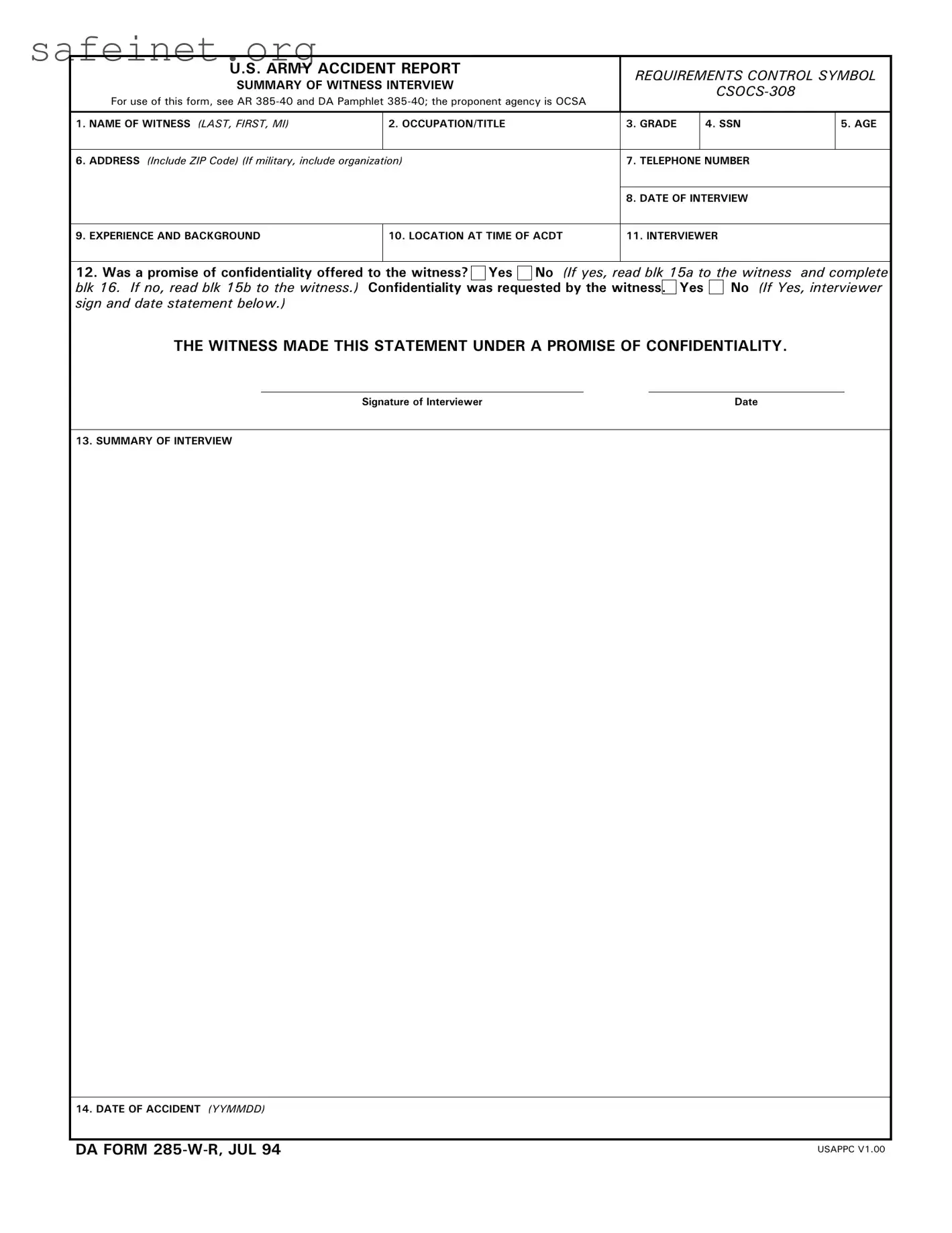The DA Form 2823, known as the Sworn Statement form, serves a purpose similar to the DA 285 W R. It is used within the military to collect testimonies under oath. This form ensures that the statements made are considered official and can be used in legal or disciplinary proceedings. Like the DA 285 W R, confidentiality is a key consideration; however, a sworn statement provides a legal backing that may not always be present in informal witness interviews.
The DA Form 3946, also referred to as the Field Record of Proceedings form, is used during investigations and captures essential data in a structured manner. Both forms require details about the witness and the accident. However, the DA 3946 is more often used in formal investigations with legal implications, while the DA 285 W R focuses more on safety and accident prevention interviews.
The AF Form 1168, which is the Statement of Suspected Criminal Activity form, also resembles the DA 285 W R in capturing witness accounts. While the AF Form 1168 is specifically tailored for criminal investigations, it shares the same goal of documenting experiences and observations during an incident. Both forms are vital in ensuring accurate reporting, but the AF Form 1168 is more aligned with criminal law.
The DD Form 1920, the Alcohol Incident Report, has similarities with the DA 285 W R, particularly in gathering testimony related to incidents involving alcohol. Both forms seek to document details to understand the circumstances better. However, the DD Form 1920 focuses specifically on incidents related to alcohol use, often in a disciplinary context, while the DA 285 W R is broader in addressing general safety concerns.
The DA Form 250, referred to as a Material Inspection and Receiving Report, serves as an official record that can include eyewitness accounts of material conditions. While it focuses more on property accountability and condition reports, both forms gather crucial information to support investigations, though their applications vary significantly, with the DA 285 W R aimed at accident prevention.
The SF 95, which is the Claim for Damage, Injury or Death form, has some parallels with the DA 285 W R. This document addresses incidents where unauthorized actions lead to claims for damages. It captures witness accounts much like the DA 285 W R, but its primary function pertains to legal claims, adding another layer of complexity that is usually absent in safety investigations.
The DA Form 7440, used for Accident Reporting, is also similar to the DA 285 W R in that it encompasses findings from accident investigations. Both forms seek to improve safety and reduce the likelihood of future incidents. However, the focus on formal accident reporting in DA Form 7440 means it often involves predetermined assessments, while the DA 285 W R prioritizes initial, informal witness interviews.
The DoD Form 2950, related to Hazardous Material Incident Reports, shares commonality in that it collects narratives about incidents involving hazardous materials. While the DA 285 W R emphasizes overall accident investigation, the DoD Form 2950 is highly specialized, aimed specifically at preventing and managing hazardous material incidents.
The FS Form 2450, the Fire Incident Report, captures details on fire-related occurrences. Similar to the DA 285 W R, this form gathers information from witnesses to understand what transpired. The focus is narrowed to fire incidents, contrasting with the DA 285 W R’s broader intent of overall safety, though accident prevention is a shared aim.
Finally, the DA Form 1, which serves as the Commander’s Assessment form, has a level of similarity in the information it seeks about incidents and personnel involved. While the DA Form 1 primarily reflects a leader's views and assessments, the DA 285 W R focuses on collecting firsthand accounts from witnesses. Both are critical for understanding incidents, but their purposes and authors vary.



 Yes
Yes 
 No
No 